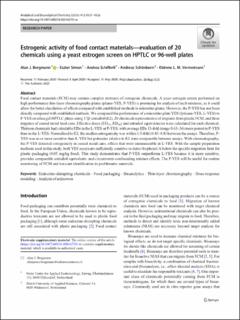Please use this identifier to cite or link to this item:
https://doi.org/10.21256/zhaw-20105| Publication type: | Article in scientific journal |
| Type of review: | Peer review (publication) |
| Title: | Estrogenic activity of food contact materials : evaluation of 20 chemicals using a yeast estrogen screen on HPTLC or 96-well plates |
| Authors: | Bergmann, Alan J. Simon, Eszter Schifferli, Andrea Schönborn, Andreas Vermeirssen, Etiënne L. M. |
| et. al: | No |
| DOI: | 10.1007/s00216-020-02701-w 10.21256/zhaw-20105 |
| Published in: | Analytical and Bioanalytical Chemistry |
| Volume(Issue): | 412 |
| Issue: | 19 |
| Page(s): | 4527 |
| Pages to: | 4536 |
| Issue Date: | 27-May-2020 |
| Publisher / Ed. Institution: | Springer |
| ISSN: | 1618-2642 1618-2650 |
| Language: | English |
| Subject (DDC): | 540: Chemistry 572: Biochemistry |
| Abstract: | Food contact materials (FCM) may contain complex mixtures of estrogenic chemicals. A yeast estrogen screen performed on high performance thin-layer chromatography plates (planar-YES, P-YES) is promising for analysis of such mixtures, as it could allow for better elucidation of effects compared with established methods in microtiter plates. However, the P-YES has not been directly compared with established methods. We compared the performance of a microtiter plate YES (lyticase-YES, L-YES) to P-YES on silica gel HPTLC plates using 17β-estradiol (E2), 20 chemicals representative of migrants from plastic FCM, and three migrates of coated metal food cans. Effective doses (ED10, ED50) and estradiol equivalencies were calculated for each chemical. Thirteen chemicals had calculable EDs in the L-YES or P-YES, with average EDs 13-fold (range 0.63–36) more potent in P-YES than in the L-YES. Normalized to E2, the median estrogenicity was within 1.5-fold (0.43–8.8) between the assays. Therefore, P-YES was as or more sensitive than L-YES but potencies relative to E2 were comparable between assays. With chromatography, the P-YES detected estrogenicity in coated metal cans, effects that were unmeasurable in L-YES. With the sample preparation methods used in this study, both YES assays are sufficiently sensitive to detect bisphenol A below the specific migration limit for plastic packaging (0.05 mg/kg food). This study demonstrates that P-YES outperforms L-YES because it is more sensitive, provides comparable estradiol equivalents, and circumvents confounding mixture effects. The P-YES will be useful for routine monitoring of FCM and toxicant identification in problematic materials. |
| URI: | https://digitalcollection.zhaw.ch/handle/11475/20105 |
| Fulltext version: | Published version |
| License (according to publishing contract): | CC BY 4.0: Attribution 4.0 International |
| Departement: | Life Sciences and Facility Management |
| Organisational Unit: | Institute of Natural Resource Sciences (IUNR) |
| Appears in collections: | Publikationen Life Sciences und Facility Management |
Files in This Item:
| File | Description | Size | Format | |
|---|---|---|---|---|
| 2020_Bergmann-etal_Estrogenic-Activity-Of-Food-Contact-Materials.pdf | 812.76 kB | Adobe PDF |  View/Open |
Show full item record
Bergmann, A. J., Simon, E., Schifferli, A., Schönborn, A., & Vermeirssen, E. L. M. (2020). Estrogenic activity of food contact materials : evaluation of 20 chemicals using a yeast estrogen screen on HPTLC or 96-well plates. Analytical and Bioanalytical Chemistry, 412(19), 4527–4536. https://doi.org/10.1007/s00216-020-02701-w
Bergmann, A.J. et al. (2020) ‘Estrogenic activity of food contact materials : evaluation of 20 chemicals using a yeast estrogen screen on HPTLC or 96-well plates’, Analytical and Bioanalytical Chemistry, 412(19), pp. 4527–4536. Available at: https://doi.org/10.1007/s00216-020-02701-w.
A. J. Bergmann, E. Simon, A. Schifferli, A. Schönborn, and E. L. M. Vermeirssen, “Estrogenic activity of food contact materials : evaluation of 20 chemicals using a yeast estrogen screen on HPTLC or 96-well plates,” Analytical and Bioanalytical Chemistry, vol. 412, no. 19, pp. 4527–4536, May 2020, doi: 10.1007/s00216-020-02701-w.
BERGMANN, Alan J., Eszter SIMON, Andrea SCHIFFERLI, Andreas SCHÖNBORN und Etiënne L. M. VERMEIRSSEN, 2020. Estrogenic activity of food contact materials : evaluation of 20 chemicals using a yeast estrogen screen on HPTLC or 96-well plates. Analytical and Bioanalytical Chemistry. 27 Mai 2020. Bd. 412, Nr. 19, S. 4527–4536. DOI 10.1007/s00216-020-02701-w
Bergmann, Alan J., Eszter Simon, Andrea Schifferli, Andreas Schönborn, and Etiënne L. M. Vermeirssen. 2020. “Estrogenic Activity of Food Contact Materials : Evaluation of 20 Chemicals Using a Yeast Estrogen Screen on HPTLC or 96-Well Plates.” Analytical and Bioanalytical Chemistry 412 (19): 4527–36. https://doi.org/10.1007/s00216-020-02701-w.
Bergmann, Alan J., et al. “Estrogenic Activity of Food Contact Materials : Evaluation of 20 Chemicals Using a Yeast Estrogen Screen on HPTLC or 96-Well Plates.” Analytical and Bioanalytical Chemistry, vol. 412, no. 19, May 2020, pp. 4527–36, https://doi.org/10.1007/s00216-020-02701-w.
Items in DSpace are protected by copyright, with all rights reserved, unless otherwise indicated.